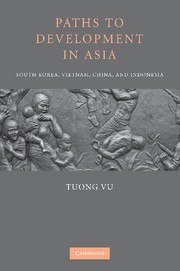Book contents
- Frontmatter
- Contents
- List of Tables and Figure
- Acknowledgments
- List of Abbreviations
- 1 State Formation Dynamics and Developmental Outcomes
- PART ONE DIVERGENT NATIONAL PATHS OF STATE DEVELOPMENT
- 2 South Korea: Confrontation and the Formation of a Cohesive State
- 3 Indonesia: From Accommodation to Confrontation
- 4 Rival State Formations in China: The Republican and Maoist States
- 5 Vietnam: Accommodation and Arrested Revolution
- PART TWO VARIANTS OF ACCOMMODATION: VIETNAM AND INDONESIA COMPARED
- References
- Index
4 - Rival State Formations in China: The Republican and Maoist States
Published online by Cambridge University Press: 04 August 2010
- Frontmatter
- Contents
- List of Tables and Figure
- Acknowledgments
- List of Abbreviations
- 1 State Formation Dynamics and Developmental Outcomes
- PART ONE DIVERGENT NATIONAL PATHS OF STATE DEVELOPMENT
- 2 South Korea: Confrontation and the Formation of a Cohesive State
- 3 Indonesia: From Accommodation to Confrontation
- 4 Rival State Formations in China: The Republican and Maoist States
- 5 Vietnam: Accommodation and Arrested Revolution
- PART TWO VARIANTS OF ACCOMMODATION: VIETNAM AND INDONESIA COMPARED
- References
- Index
Summary
“BRINGING THE STATE BACK IN”: MODERN CHINESE HISTORIOGRAPHY
Until recently, Western scholarship on Chinese politics was thoroughly mesmerized by the revolutions that swept through China throughout the twentieth century (Young 2002, 1). China's modern state formation and state-building experiences have been either neglected or analyzed under the rubric of revolutions (e.g., Skocpol 1979). This tendency has compartmentalized modern Chinese history into “the abortive revolution” led by the Chinese Nationalist Party (Guomindang, or GMD) and the communist revolution under the leadership of the Chinese Communist Party (CCP) (Esherick 1995). The history of modern China became the history of (first nationalist, then communist) revolutionary movements: their leaderships, organizations, and strategies preoccupied scholarship, obscuring all other important topics.
Conceptually and empirically, another history of modern China, centered on states, has been largely overlooked. Until recently, only limited research had been done on the Republican state that ruled China from 1927 to 1937 (Edmonds 1997). Scholarship shows that it was a viable state that engineered important socioeconomic changes before its collapse on the mainland in 1949 (e.g., Kirby 1990; 2000b; Strauss 1998; Wakeman and Edmonds 2000). After relocating to Taiwan, the leaders of this state went on to develop the island into an industrial powerhouse.
The Maoist state has suffered the same neglect as its rival, even though as a revolutionary movement the CCP has attracted greater attention from scholars than the GMD. Yet Mao Zedong and his comrades did not just lead a radical revolution; they built a powerful state to realize their ambitions.
- Type
- Chapter
- Information
- Paths to Development in AsiaSouth Korea, Vietnam, China, and Indonesia, pp. 71 - 99Publisher: Cambridge University PressPrint publication year: 2010



